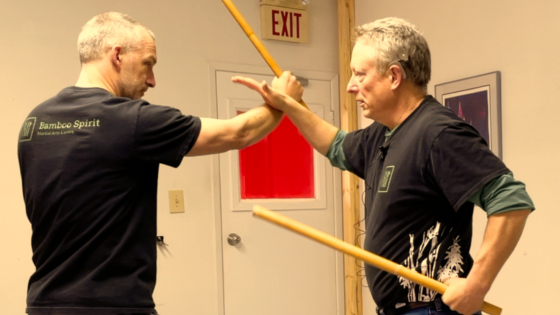Archie Moore’s Crossed Guard
Recently, I came across a fantastic YouTube channel called The Modern Martial Artist. This channel has tons of videos analyzing many boxers and martial artists. The technical breakdowns are often superb. I have found several videos explaining techniques that are amazingly similar to martial arts that I’ve studied. One of them concerns Archie Moore’s crossed guard.
If you are not able to view this video, click here
In watching this video, it is apparent that Moore’s crossed guard is eerily similar to the beginnings of the down block that you see in many martial arts styles, notably karate.
One could argue that it is also identical to the midpoint of the double sinawali drill.

In the picture above, Moore’s right hand has crossed his centerline and is chambered by his left shoulder. His left/lead hand is around his waist area and located at his centerline.

There are some differences between Moore and the martial arts version of this position. First, Moore bends his lower arm and has it positioned closer to his centerline. Secondly, Moore is slightly bent forward at the waist for defensive purposes.
I first saw the crossed guard position when George Foreman relaunched his boxing career in 1987, after a ten-year layoff. It seemed so unconventional but amazingly effective for him. Then I learned that Archie Moore is considered by many to be the original creator of this defensive style.
See the below video:
In looking at the video, one can see different boxers using the crossed guard in different ways. At the 0:22 mark, Gene Fullmer, a middleweight, raised both of his arms in the crossed position to protect his head.
Forward to the 0:35 mark. Here Ken Norton, a feared heavyweight in the 1970s, used his right hand to parry Larry Holmes’ jab. Very effective.
At the 1:09 to the 1:14 mark, Gene Fullmer (in white trunks) uses the crossed guard to protect his midsection.
In seeing these examples, one can see that a boxer can raise the crossed guard up or down to defend the head or the midsection. It appears to be an active defensive posture.
I think that the crossed guard is particularly advantageous for those who are older or not as mobile as they were in their younger days.
A downside that I can see is that the crossed guard may slow down or hinder the defender’s counter-attack. On the other hand, it is nearly impossible to catch EVERY attack and counter. The traditional teaching methodology in many martial arts schools is Person A attacks, and then Person B defends and counters.
I think that there is a small problem with this. This methodology assumes that the defender will be able to see, defend, and respond to an attack without suffering any damage. I think that there is a place for defensive shells/postures like the above that allow for a defender to wear down the attacker before responding.
There are many situations where a defensive shell or posture may not be appropriate. I sure as hell wouldn’t use this against a knife attack, for example. Different situations call for different tactics.
Applications for the down block range from parrying, breaking, joint locks, and takedowns. The video below has an excellent compilation of techniques based on the down block.
I love kata applications as much as anyone. Note, though, that the two karatekas performed many of the bunkai against incoming attacks. Success occurs every time! Is that realistic? There is no exploration of whether the down block can be used as a defensive posture/shell.
If you were to freeze the down block midpoint and make some minor adjustments, you have the crossed guard. One can argue that this can be an application of the down block.
The similarity between Moore’s crossed guard and the midpoint of the karate down block or double sinawali fascinates me. I think that this is an area worth exploring.
Over to you, what do you think?
Share this post:
- Click to share on Twitter (Opens in new window)
- Click to share on Facebook (Opens in new window)
- Click to share on LinkedIn (Opens in new window)
- Click to share on WhatsApp (Opens in new window)
- Click to share on Nextdoor (Opens in new window)
- Click to share on Pinterest (Opens in new window)
- Click to email a link to a friend (Opens in new window)
Tags In
Brian Johns
Related Posts
4 Comments
Leave a Reply Cancel reply
Categories
- Arnis/Kali/Eskrima (113)
- Book Review (8)
- DVD Reviews (3)
- Guest Post (4)
- Inspiration (24)
- Martial Arts (99)
- My story (92)
- Safety (14)
- Tips & tricks (6)
- Uncategorized (3)
- YouTube Videos (8)






[…] can peruse for hours. Even blogs are packed with information! For example, I once wrote a post on Archie Moore’s famous cross-guard defence. It’s all out […]
[…] world for decades, teaching Modern Arnis as “the art within your art”. He was known to say “it is all the same!” This is truly a profound insight into the world of martial arts training and practice. The more […]
[…] boxers are often measured by their quality of opposition. Muhammad Ali and Sugar Ray Leonard had the […]
[…] Archie Moore’s Crossed Guard […]